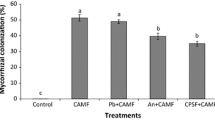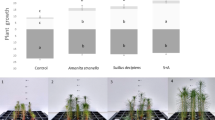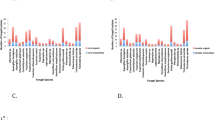Abstract
C. pannorum was isolated in low frequencies and only in the colder months from untreated soil and leaves and from those treated with Captan, Dicloran and Thiram. The fungus was isolated throughout the year as the major species from Verdasan-treated substrates and it occurred with increased frequencies immediately after application of the fungicide. The abundance of C. pannorum on Verdasan-treated substrates was attributed to the ability of the fungus to utilise the fungicide rather than to the absence of faster growing competitor species. C. pannorum was shown to be a slow growing and moderately cellulolytic fungus with maximum rates of growth, germination and cellulose clearing at between 15° and 20°C. Increasing concentrations of the fungicides retarded or prevented growth and activity of the fungus. C. pannorum could grow, germinate and clear cellulose in higher concentrations of Verdasan than could other species studied. C. pannorum was more tolerant of HgCl2 than of Verdasan. The fungus could detoxify up to 3 μg/ml active ingredient of Verdasan (=120 μg/ml of the formulated fungicide) in liquid culture.
Similar content being viewed by others
References
Apinis, A. E. 1958. Distribution of microfungi in soil profiles of certain alluvial grassland. — Agnew Pfl. Soziol. 15; 83–90.
Ashworth, L. J. and Amin, J. V. 1964. A mechanism for mercury tolerance in fungi. — Phytopathology 54: 1459–1463.
Carmichael, J. W. 1062. Chrysosporium and some other aleuriosporic Hyphomycetes. — Can. J. Bot. 40: 1137–1173.
Corden, M. E. and Young, R. A. 1965. Changes in the soil microflora following fungicide treatments. — Soil Science 99; 272–277.
Dickinson, C. H. and Kent, J. W. 1972. Critical analysis of fungi in two sand-dune soils. — Trans. Brit. mycol. Soc. 58: 269–280.
Domsch, K. H. 1960. Das Pilzspektrum einer Bodenprobe. — Arch. Mikrobiol. 35: 310–339.
Domsch, K. H. and Gams, W. 1969. Variability and potential of a soil fungus population to decompose pectin, xylan and carboxymethyl cellulose. — Soil Biol. Biochem 1: 29–36.
Domsch, K. H. and Gams, W. 1972. In. fungi in agricultural soils. — Longman. London.
Eggins, H. O. W. and Pugh, G. J. F. 1962. Isolation of cellulose decomposing fungi from soil. —Nature 193: 94–95.
van Faassen, H. G. 1073. Effects of mercury compounds on soil microbes. — Plant & Soil 38: 495–487.
Greenway, W. 1073. In vitro tests of the toxicity of mercury compounds to Pyrenophora avenae. —Trans. Brit. mycol. Soc. 60: 87–97.
Ivarson, K. C. 1973. Fungal flora and rate of decomposizion of leaf litter at low temperatures. —Can. J. Soil Science 53: 79–84.
Kobayashi, Y., Hiratsuka, N., Korf, R. P., Tubaki, K., Aoshima, K., Soneda, M. and Sugiyama, J. 1967. — Mycological studies of the Alaskan Arctic. — Rep. Inst. Ferment. Osaka 3: 1–138.
Kuthubutheen, A. J. and Pugh, G. J. F. 1977. The effects of fungicides on the occurrence of thermophilous leaf-surfaces fungi. — Mycopathologia 63: 131–141.
Latter, P. M. and Heal, O. W. 1971. A preliminary study on the growth of fungi and bacteria from temperate and antarctic soils in relation to temperature. — Soil Biol. Biochem. 3: 365–379.
Poole, N. J. and Price, P. C. 1971. The occurrence of Chrysosporium pannorum in soils receiving incremental cellulose. — Soil Biol. Biochem. 3: 161–166.
Pugh, G. J. F. 1965. Cellulolytic and kerationphilic fungi recorded on birds. — Sabouraudia 4: 85–91.
Pugh, G. J. F. and Evans, M. O. 1970a. Keratinophilic fungi associated with birds. I. — Trans. Brit. mycol. Soc. 54: 233–240.
Pugh, G. J. F. and Evans, M. O. 1970b. Keratinophilic fungi recorded on birds. II. — Trans. Brit. mycol. Soc. 54: 241–251.
Rautela, G. S. and Cowling, E. B. 1966. Simple cultural test for relative cellulotic activity of fungi. — Appl. Microbiol. 14: 892–898.
Ross, I. S. 1974. Non-protein thiols and mercury resistance of Pyrenophora avenae. — Trans. Brit. mycol. Soc. 63: 77–83.
Ross, I. S. and Old, K. M. 1973a. Mercuric chloride resistance of Pyrenophora avenae. — Trans. Brit. mycol. Soc. 60: 293–300.
Ross, I. S. and Old, K. M. 1973b. Thiol compounds and resistance of Pyrenophora avenae to mercury. — Trans. Brit. mycol. Soc. 60: 301–310.
Tansey, M. R. 1971. Agar-diffusion assay of cellulolytic ability of thermophilic fungi. — Arch. Mikrobiol. 77: 1–11.
Taylor, J. J. 1970. Further classification of Sporotrichum species. — Mycologia 62: 797–825.
Traen, A. E. 1914. Untersuchungen über Bodenpilze aus Norwegen. — Nyt. Mag. Naturvid. 52: 20–121.
Vartiovaara, V. 1935. Studies on the metabolism of soil fungi. — Acta agral. fenn. 32: 1–112.
Warcup, J. H. 1950. The soil plate method for isolation of fungi from soil. — Nature 166: 117.
Warcup, J. H. 1951a. The ecology of soil fungi — Trans. Brit. mycol. Soc. 34: 376–399.
Warcup, J. H. 1951b. Effect of partial sterilization by steam or formalin on the fungus flora of a old forest nursery soil. — Trans. Brit. mycol. Soc. 34: 520–532.
Warcup, J. H. 1955. On the origin of colonies of fungi developing on soil dilution plates. — Trans. Brit. mycol. Soc. 38: 298–301.
Williams, J. I., Pugh, G. J. F. and Morris, B. 1972. Consideration of some of the factors responsible for fibre accumulation on golf course greens at Wollaton, Nottingham. — J. Sports Turf Res. Inst. 48: 36–43.
Williams, J. I. and Pugh, G. J. F. 1974. Fungal biological flora: Chrysosporium pannorum (Link) Hughes. — Int. Biodetn. Bull. 10: 75–80.
Williams, J. I. and Pugh, G. J. F. 1975. Resistance of Chrysosporium pannorum to an organo mercury fungicide. — Trans. Brit. mycol. Soc. 64: 255–266.
Author information
Authors and Affiliations
Rights and permissions
About this article
Cite this article
Kuthubutheen, A.J., Pugh, G.J.F. Effects of temperature and fungicides on Chrysosporium pannorum (Link) Hughes. Antonie van Leeuwenhoek 45, 65–79 (1979). https://doi.org/10.1007/BF00400780
Received:
Issue Date:
DOI: https://doi.org/10.1007/BF00400780




